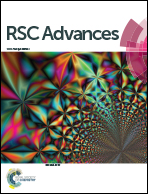Identification of unusual C–Cl⋯π contacts in 2-(alkylamino)-3-chloro-1,4-naphthoquinones: effect of N-substituents on crystal packing, fluorescence, redox and anti-microbial properties†
Abstract
The chemo-selective reaction of 2,3-dichloro-1,4-naphthoquinone with different primary amines affords access to a series of derivatives, such as 2-(alkylamino)-3-chloro-1,4-naphthoquinone (1–6) and 2-(benzylamino)-1,4-naphthoquinone (7), in good yields. All the compounds 1–7 were characterized thoroughly by microanalysis, standard spectroscopy and thermogravimetric methods. The supramolecular structures of 1–4 and 7 were studied by means of single-crystal X-ray diffraction to gauge the influence of substituents that are present on the amine functionality on the association of molecules in the solid state. The study showed that the introduction of various amine N-substituents induces conformational changes that apparently modify the nature and number of donor–acceptor sites for noncovalent interactions, leading to diverse crystal packing patterns. Interestingly, the introduction of 2-(benzylamino)- and 2-(2-pyridylmethylamino)- substituents in 2 and 4 successfully switched on the C–Cl⋯π synthon, which is scarcely seen in the crystal packing of organic molecules. Compounds 1, 2, 4 and 5 fluoresced in the range of 350–620 nm with concomitant Stokes shifts of 81, 131, 141 and 131 nm, respectively, and their cyclic voltammograms evidenced two quasi-reversible single-electron waves. All the compounds (except 5) exhibited their first endothermic peak on the DTA curves without any mass loss due to the phase change, attributable to the melting points of the respective compounds. Remarkably, compound 5 exhibited an enhanced antibacterial activity against S. aureus and proved to be a more potent antibacterial agent than the well-known drug “ciprofloxacin”.


 Please wait while we load your content...
Please wait while we load your content...